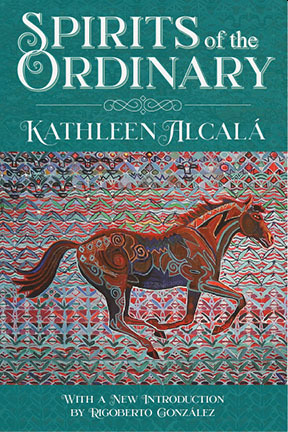Kathleen Alcalá
SPIRITS OF THE ORDINARY: A TALE OF CASAS GRANDES
With a New Foreword by Rigoberto González
Seattle: Raven Chronicles Press, 2021. ISBN 987-0-9979468-8-8
Reviewed by Judith Roumani1
The original edition of this prizewinning novel appeared in 1997, but we are fortunate that a new edition has appeared recently, to delight those who are not yet familiar with this excellent writer. The beautiful painting of a galloping horse with Native American-style patterns behind it, entitled “Red Pony,” is by Alfredo Arreguín.
The novel focuses on the mostly hard lives of individuals from various ethnic groups in the mid-nineteenth century living along the U.S.-Mexican border. The U.S. had recently annexed Texas from Mexico, and Mexico in the 1870s was involved in a violent war between its army and Indian tribes, a war of annihilation. Among them were the Apaches, ruthless Indian warriors who struck fear in the hearts of other Indians. The general population was officially Catholic, but many had Jewish or Native roots that they concealed. This was an age when ethnic diversity was not appreciated, but converso descendants and Indians could form alliances, and others such as sexual minorities did exist, if in fear of the majority.
Alcalá’s novel reads often like a group of discrete stories presenting characters that have little to do with each other, as in a collection of folktales. As the book continues, we eventually see how their lives are linked, and the stories come together. There is the ongoing conflict between the Mexican army and the doomed Indian way of life. The Indians have become part of the national economy as workers in the mines or farms, but sometimes desert temporarily for their own religious festivals, an intolerable situation for employers who depend on their labor. Even if they are not warlike, and stay out of the paths of Mexicans, the army will come out and find the Indians, their weak attempts at self-defense provoking a massacre.
The subtitle involving Casas Grandes refers to a high, inaccessible valley where large caves had been turned into dwellings by an ancient people and where one Native group seeks sanctuary. Their myths and beliefs, as in the stories of Gabriel García Marquéz of Colombia or Miguel Angel Asturias of Guatemala, sometime inform the texts with a touch of magical realism. There is an additional element of syncretism, though: perhaps the most important character in the book, Zacarías, whose father is a practicing secret Jew, brings elements of Judaism, tells them biblical stories and psalms, perpetuating to a small extent his father’s love of Judaism and Kabbala. Zacarías, very different from his father, is a gold prospector who deserts his family to live by himself in the mountains, has visions, and later becomes a spiritual healer for the Indians. After a battle, Zacarías heads northward to Texas. When Jews are scapegoated for the disturbances, his own parents barely escape murder in a threatened pogrom, his father having to burn his own precious library of old Jewish books, and they seek safety in Mexico City. Zacarías, eventually finding a well of water identical to the one in his parents’ courtyard, joins a group of Jews. Gabriel, the son of Zacarías, who had gone to the United States to study, falls in with missionaries, and himself becomes an itinerant Evangelist preacher.
Another element of nonconformism consists of the beautiful young twins, Membrillo and Manzana, who are itinerant water diviners, and are eventually tragically murdered. Their quality as doubles is too disturbing for ordinary people, as double-ness blurs the boundaries of individual identity, bringing it into question in an uncomfortable way. Their questionable sexuality combines with their spiritual gift as water diviners to make them unfit for the ordinary world. A female American photographer, Corey, who has had to disguise herself as a man in order to travel these regions freely, photographed them, before she is run out of town by the priest. Her photos that survive will become a historical record of this time on the cusp of change and new opportunities, yet still hidebound by the iron grip of convention. Another example is Magdalena, a young woman of Indian descent coerced into sexual slavery and then marriage, who inherits wealth from her Irish husband and becomes a powerful businesswoman.
Gabriel somehow acquires a manuscript that his father has written in his later years:
“Hidden within this hodgepodge of proverbs, poetry, stories and prayers, songs, recipes and mathematical formulas, scientific experiments and metaphysical speculations, remedies and practical advice for the weary traveler, lay, to my amazement, a history of my own family” (225).
Zacarías seems to have written one of those syncretistic multi-genre books named seferinos, produced and kept secretly sometimes in the families of descendants of conversos (a forthcoming anthology edited by Seth Kunin, examines the genre).
Thus, extreme social coercion toward conformity presses most of the non-conforming characters of the borderlands into itinerant lifestyles in the 1870s. Behind the façade of conformism, and the implicit threat of violence behind it, a few individuals managed to express themselves and exercise their creativity. Alcalá’s enthralling novel is a song in praise of the historical resourcefulness and courage of people of different ethnicities and identities in the American-Mexican borderlands.
1 Judith Roumani is the editor of Sephardic Horizons.

